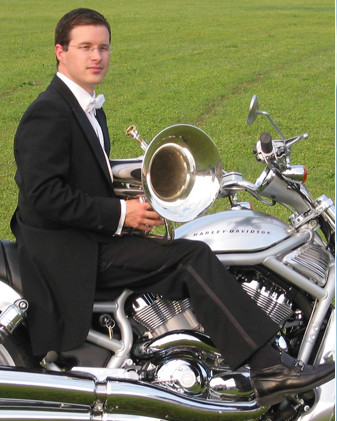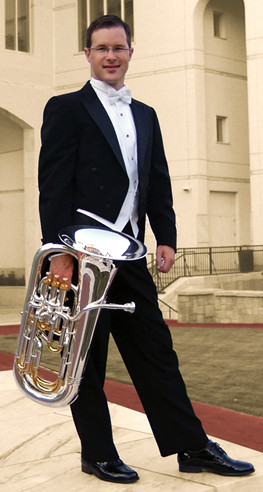“Hands-On”! That is how euphonium virtuoso Adam Frey describes the ideal for the International Euphonium and Tuba Festival to be held June 21-27, 2015 in Atlanta, Georgia. The participants eat all of their meals together, and attend all of the presentations together-since only one presentation is offered at a time. Access to guest artists is close up as well, with each artist presenting a recital performance in addition to working with students in masterclasses, warm up sessions, and coachings.
A native of Atlanta, Adam brings the IET Festival to his home town after pursuing his passion for great music played on the euphonium around the globe. One can get a sense of his travels from the faculty and participants at the festival, and Frey’s international appeal serves to attract both from all over the world. “The Fourth Valve” tm is delighted to present International Euphonium Virtuoso Adam Frey as the next respondent of our interview series. Enjoy!
 1. How did the International Euphonium and Tuba Festival come about, and in what ways have you strove to make it a unique experience amongst the various conferences? The event started in 2004 with 14 participants. I wanted to make something special for tuba and euphonium that combined high level performances like International Tuba and Euphonium Conference, but also offered a great opportunity for students to work closely with professionals. Lastly, I wanted to give participants the chance to PLAY! Participants can have as many as 11 performance opportunities between the ensemble concerts, participant recitals, master classes, lessons, and solo competition. I think the massive staff of teachers and their desire to connect with the participants makes it a special experience.
1. How did the International Euphonium and Tuba Festival come about, and in what ways have you strove to make it a unique experience amongst the various conferences? The event started in 2004 with 14 participants. I wanted to make something special for tuba and euphonium that combined high level performances like International Tuba and Euphonium Conference, but also offered a great opportunity for students to work closely with professionals. Lastly, I wanted to give participants the chance to PLAY! Participants can have as many as 11 performance opportunities between the ensemble concerts, participant recitals, master classes, lessons, and solo competition. I think the massive staff of teachers and their desire to connect with the participants makes it a special experience.
2. What was it like to perform as a soloist with the Boston Pops?
This was one of the most impressive experiences of my life. Playing 3 concerts to a packed house each night and receiving standing ovations and cheers was pretty incredible and memorable. I think the quality of the ensemble was outstanding as well as the energy of the audience and the acoustic of Symphony Hall combine to make it a concert experience where you can really achieve a pinnacle of your performance abilities. I practiced insanely hard for the concerts and to prepare mentally and those experiences and techniques still remain with me today.
3. What piqued your interest in commissioning new works? Any favorite stories working with composers?
The euphonium is young, let’s face it. So helping to generate new music has become a passion of mine. When you have the opportunity to develop and break ground on new projects, there is an incredible sense of ownership. Hopefully, we can introduce the euphonium to as many composers as possible and, in turn, they might enhance euphonium parts in their future compositions. In this way, we can create a great sense of momentum for the instrument.
Allen Feinstein’s concerto was very memorable! We spent a lot of time talking and then all of a sudden the 1st movement showed up and it was incredibly difficult. I told him the rest of the piece can’t be this crazy. So he adjusted the demands, but it was a great opportunity to be creative. I was also able to make a few recommendations like having the euphonium on a counter melody in certain spots and to use a mute for a color change.
4. Why is the euphonium a more popular timbre choice than baritone or valve trombone, and do you see any need for euphonium players to embrace these tone colors and traditions?
I believe the euphonium is more popular because the sound has a greater timbrel contrast from the trombone. The baritone and valve trombone are, of course, somewhat different as well, but the euphonium has the most distinct tonal palette. As an arranger, I think that greater contrast offers more colors and opportunities. The euphonium provides a broader range spectrum (top to bottom) and lastly, I feel as though the sound is broader and a little less direct.
5. What do you think of when you think of Leonard B. Falcone, and what did he mean to the instrument?
I think of someone that pushed the limits and was a major ambassador for the instrument. Incredible tonging and flair with a strong tradition of education. He was certainly one of the best proponents of the instrument in the US and made a large impact of school band education.
6. What is your concept of sound on the euphonium, and the place of vibrato within it?
This is certainly interesting question! What is dark to one person, may be bright to another. I like to think about the ideals of projection, clarity, warmth, and color when I think about my playing. I hope to explore and convey a wide variety of possibilities within those areas.
I look at vibrato as an additional option on top of the previous things. I like to use vibrato as a musical tool that can offer a subtle warmth, an intensifying gesture or an impassioned appeal. The absence of vinbrato can add a cool and calm feeling to a phrase. My preference is that the vibrato not be an always on, nor an overpowering aspect of sound. It should add something when used.
7. What differences have you noted in teaching and playing styles between the US, Switzerland and Korea? 
I think everyone is going for the same thing in regards to teaching, namely: a good physical setup, a quality tone, an efficient use of air, a reduced use of muscle tension, and that creative spark.
There are differing levels of creativity as well as the color palettes in use. Some artists like subtle colors, others, very strong intense colors! Some are even intentionally monochromatic. Yet, they are all artistic. I generally strive to play with very vibrant colors, but sometimes there is more beauty in a subtle approach that might suit a particular piece better than vibrancy or bombast.
I think also that culture and personal character come into play as well. Someone that is more introverted likely enjoys playing a little more subdued but still is feeling the music. The types of ensembles in the country makes a big difference as well. Countries with high-intensity brass bands(like Switzerland and the UK), tend to have much higher technical demands and soloist requirements placed on them in the many competitions. By contrast, wind band focused countries(US and Japan,) tend to have a a basic approach which emphasizes a greater focus on tone and blend-the art of the ensemble player. The brass band players have ensemble skills for sure, but they are different. I always remember my first brass band rehearsal and was shocked by the challenging music.
8. Who are your musical heroes?
Steven Mead as an inspiration to aspire towards a career as a soloist and be charismatic; Brian Bowman for sound and character; Art Lehman for virtuosity and ease; Jaqueline de Pre for her intensity and passion; David Randolph
(my teacher) as an incredibly sensitive chamber musician and champion of new music; James Gourlay for his wit, insights, and playing; Patrick Sheridan for showmanship and flair! There are more….
Non-musical?
Malcolm Gladwell as a motivator and de-constructor of success; my dad, Steve Frey, for his incredible work ethic and “can-do attitude”; Jack Welch and Bill Gates as leaders in the business world that stuck with their visions and made them happen.
9. What are your thoughts on the euphonium in chamber music, is tuba quartet enough?
No, we need to explore as many options as possible. I try to work chamber music into as many programs as possible. Soloist with brass quintet, duets with saxophone or trumpet, brass ensemble. We need more.
I also think greater explorations in jazz would be very helpful. This is a great medium that I want to play more of, but just don’t have the time to really craft my skills. I am still hoping though….
Listen to Adam perform excerpts from his CD recordings…
c. 2015 David William Brubeck All Rights Reserved. www.davidbrubeck.com
Images Courtesy of euphonium.com


